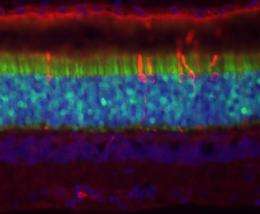Gene therapy sets stage for new treatments for inherited blindness, researchers say

Veterinary vision scientists at the University of Pennsylvania have safely and successfully used a viral vector in targeting a class of photoreceptors of the retina called rods, a critical first step in developing gene therapies for inherited blindness caused by rod degeneration.
In this study, the viral vector, or missile that carries the genetic material designed to correct a DNA mutation, was not intended to treat a disease but to demonstrate through the use of a fluorescent protein that a safe and effective viral cocktail could be delivered inside rod cells.
The next major challenge that vision researchers face is to target these photoreceptor cells for treatment, as the majority of retinal degenerative diseases are caused by mutations that damage these cells. Photoreceptors are the cells in the retina responsible for capturing light and transforming it into an electrical signal that will be interpreted by the brain.
A consortium of researchers from Penn and the University of Florida used a specific adeno-associated virus, AAV2/5, to carry the gene of a green fluorescent protein. The scientists tested whether three different promoters, pieces of DNA that play the role of a switch, could turn on the production of the green fluorescent protein in rods in dogs. Two of the three viral cocktails were able to turn on the production of the green fluorescent protein specifically in rods, while the third viral cocktail targeted rods, cones and other retinal cells; however only the proper concentration of each viral vector proved to be just right. Efficient and specific rod transduction, together with preservation of retinal structure, was achieved with both mOP and hGRK1 promoters when viral titers in the order of 1011 vg/ml were used.
"Now that we've demonstrated this type of delivery can be accomplished, " said William A. Beltran, assistant professor of ophthalmology at Penn's School of Veterinary Medicine and director of the study, "the next step is to target common rod degenerations using canine models that mimic the human diseases. The delivery of a viral vector, coupled with a rod-specific promoter is likely to be the safest and most efficient approach to correct diseases such as X-linked and autosomal dominant retinitis pigmentosa, both of which lead to complete blindness."
A form of childhood blindness called RPE65-Leber's congenital amaurosis, LCA, is the first — and to this date the only — inherited retinal disease for which corrective gene therapy is currently being tested in three on-going clinical trials. This treatment was first developed and perfected in dogs by some of the scientists who participated in the present study before its use in human patients.
The study appears in the current issue of the Journal of Gene Therapy.
















